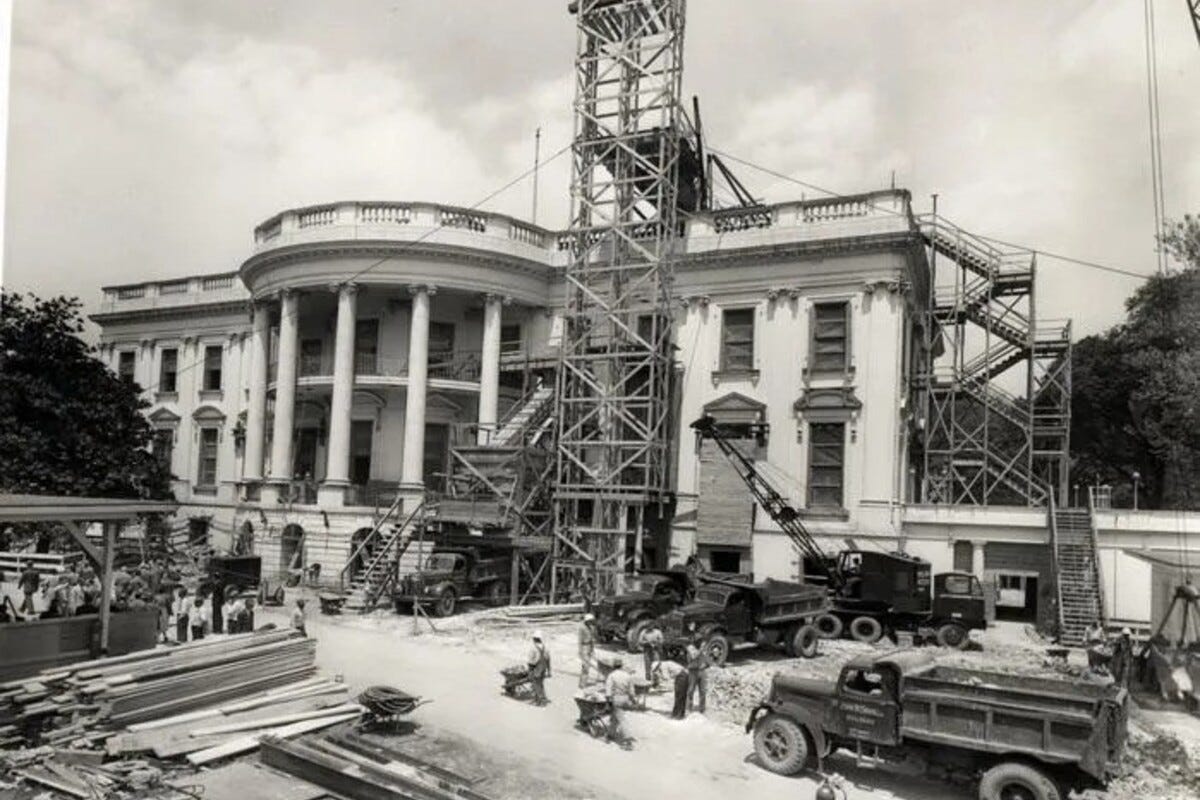Not to Worry About the Orange Man’s Moves at the White House
She’s a sturdy old lady, The People’s House, and has changed many times throughout her history. Did you know that Lincoln never slept in the Lincoln Bedroom?
I didn’t, but the ridiculous ballroom proposal set me to checking a few things out.
The White House’s design was chosen in an open competition and construction began in 1792 under chosen architect James Hoban. Completed in 1800, John Adams was the first president to live in it, and my personal favorite, Thomas Jefferson, was the next to lay a presidential head on the pillow.
As one might imagine, the building included the latest in lighting, plumbing, heating, with additional functional modifications to follow as they became available.
Then the Brits burned it down during the War of 1812, which one might call its original major rejuvenation. Stuff happens.
Four years later, after chasing the English back home for the second time, the building was repaired and reopened to the public by 1818. Its next major addition occurred in the early 1830s when the north portico was added, giving the White House one of its iconic external looks, approaching what might be more recognizable today.
Yet, there’s more to come, so stay tuned.
President Teddy Roosevelt got his hands on it for a major renovation in 1902. Roosevelt’s large family apparently required more space, so architect firm McKim, Mead & White were hired. As part of this, what became the West Wing, which accommodated offices and additional administrative space was effectively created, relocating the presidential offices.
Less than a decade later, under President William Howard Taft the Oval Office was built within that expanded office wing. Time was marching on and the expansion of the White House marched with it, as the nation itself grew larger and more complex. In 1927, under a Calvin Coolidge presidency, there was significant work adding a third floor above the main residence, including both guest and service rooms.
In 1948, thirteen years after I was born, and entirely without my permission, President Harry Truman got his hands on the place.
Prior to that, a number of unsettling events had occurred, including The Great Depression, Franklin Roosevelt’s New Deal, the Second World War, my father’s work in the wood shop at Douglas Aircraft, and the family Victory Garden.
Roosevelt was far too busy too mess with the White House, but Harry Truman, along with and in between firing General MacArthur and dropping the world’s only two atomic weapons, had the White House inspected from stem to stern, roof to basement.
Like the Corvair General Motors was yet to build, it was unsafe at any speed.
The entire interior structure was failing. Floors sagged several inches; chandeliers in the State Dining Room swayed when people walked on the upper floors. The second floor was sinking into the first — the East Room floor had dropped more than 18 inches in some places.
Engineers discovered that wooden beams had rotted, and the load-bearing supports were inadequate to handle the cumulative weight of modern amenities such as plumbing, radiators, and heavier furnishings. The exterior walls remained largely sound, but its interior brick walls and joists had deteriorated after more than 140 years of neglect and modifications. Decades of ad-hoc renovations such as new bathrooms, wiring and pipes had cut through load-bearing beams, weakening them to possible collapse.
Inspectors drilling test holes in floors, found powdered wood dust instead of solid timber, certain evidence of dry-rot. The electrical wiring was discovered to be dangerously outdated, strung haphazardly through old walls and prone to short circuiting, while heating ducts and plumbing lines were leaky and unsafe. Several small fires had already occurred.
The Secret Service was so concerned that they warned Truman the White House could literally collapse if the family stayed.
So, they moved into Blair House, the residence across Pennsylvania Avenue, where foreign dignitaries often stayed. The photo at the top of this essay indicates the enormity of these ongoing White House renovations. Congress approved a complete gut renovation during 1949 though 1952, while the entire interior was demolished, a new steel and concrete frame erected inside the preserved exterior walls, and new basements and sub-basements constructed. The president and his family returned to the newly reconstructed White House on March 27, 1952, near the end of his second term.
The reconstruction had lasted about three years. Truman was the only president to live in both the original pre-renovation structure and the fully rebuilt steel-frame version that remains today.
Asked what he thought of it, Truman admired the engineering improvements, but disliked that the “old house” feeling was gone. “The old building had a soul, but this one seems to have lost it.”
He often said it felt like living “in a new hotel built inside an old shell.” This is exactly the same complaint about ever reconstructing the East Wing the Orange Man has so imperiously torn down.
And yet, as I hope I have confirmed, The White House, The Nation’s House, is a living, breathing building. It has survived the torments and insinuations of many presidents and stayed true to its concept.
Until now.
Until the Orange Man.
I know in my heart, we will have another Rose Garden and a reconstructed East Wing. Every addition to America’s House has been made in good conscience and useful purpose, never to satisy the fleeting ego of a temporary president, for the presidency is by constitution, temporay.
There is no building in America as comprehensibly detailed as The Nation’s House… the 1948-52 project saved the building for future generations — every president since, including the Orange Man, has lived in the structurally modern White House that Harry Truman rebuilt.
My house, your house, our house is a survivor of what has often been called the American experiment in representative democracy.
It endures, patched and repaired and rebuilt, dedicated to the experiment.

